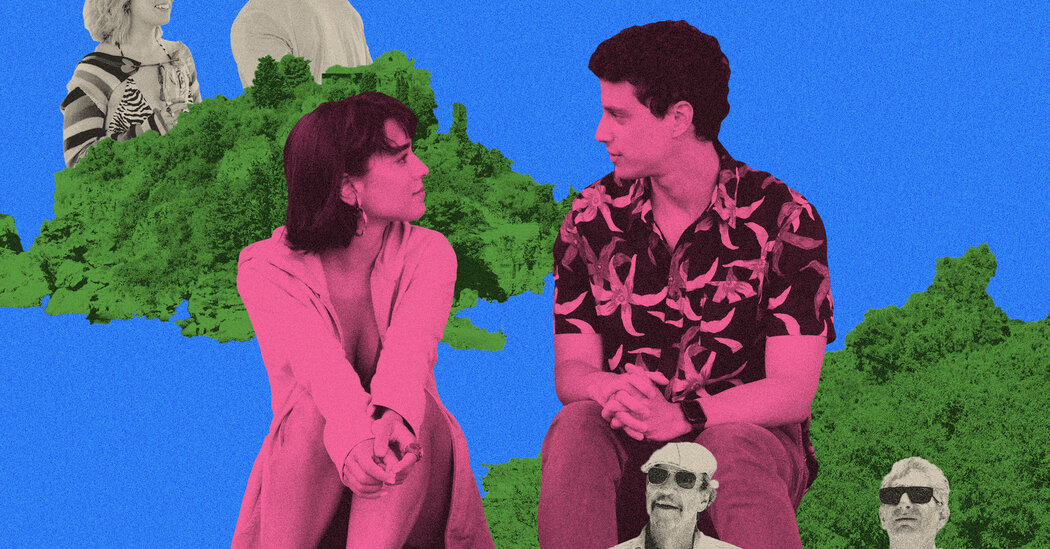An Adventure in the White Lotus: Monica Vitti’s “White Lotus” (L’ Avventura) and Harper Spiller (Noto) in “The White Lotus”
In Antonioni’s film, Vitti’s wealth and beauty grant her character access to a world of glamour, but they also trap her in a lie, concealing a real world of rot and corruption. An “avventura” is also a term for an illicit affair, but since nothing much happens in the film, and its central mystery is never solved, it is ironic that L’ Avventura means “the adventure”. Everyone in this season of “The White Lotus” gets into trouble. For both show and film, “love” is a dance of deception and self-delusion, in which it’s hard to tell who’s the mark.
The only character who still clings to purity — the only innocent left to corrupt — is Harper Spiller, played by Aubrey Plaza. And she is the one who ends up in Noto, recreating the Monica Vitti scene in the piazza. Like Claudia, Harper has drifted here by accident — by virtue, another character observes, of being pretty. The newly rich wife of a tech founder, she has come on a luxury vacation at the invitation of his college roommate. Harper is suspicious of all the things that happen when you get rich: old friends who come suddenly after you get rich; rich people who spend their lives drifting from one fantasy locale to the next. In Noto, she finds herself alone and surrounded by men, exactly like Vitti. Just as in the film, the scene feels over the top and surreal — part paranoid fantasy, part dissociative experience, and even stranger now that it’s 2022, not 1960, and Aubrey Plaza doesn’t cut quite so otherworldly and surprising (for Noto) a figure as the statuesque blonde Vitti did.
The experience of being looked at is what we are watching as we watchHarper drift through the crowd. Along with Tanya — who aims to imitate Vitti but is instead brutally compared, by a tactless hotel manager, to Peppa Pig — she offers a metaphor for how thoroughly we can give ourselves over to imposture.
Antonioni started working during the Italian neorealism movement, when films were shot on location, making use of nonactors, telling stories about working-class people and poverty and despair. But it was “L’Avventura,” with its focus on the alienation of the moneyed, that made him internationally famous. I know this because I took an Italian-neorealism class during a junior year abroad in Paris, and — not surprisingly, I suppose, for the kind of person who takes an Italian-neorealism class during a junior year in Paris — I, too, preferred Antonioni’s trilogy about disaffected rich people to the stuff that had come before: children stealing bicycles, Anna Magnani worrying about unpaid bills, that sort of thing. It is more pleasant to have our moral judgments projected into a world of pleasure than it is to watch Struggle.
In “Triangle of Sadness,” which won the Palme d’Or at Cannes, the social hierarchy on a luxury cruise turns upside down after a shipwreck leaves plutocrats and model-influencers dependent on the survival skills of a Filipina toilet attendant. “The Menu” is a satirical horror movie about high-end foodie culture in which the celebrated chef of an exclusive restaurant on a private island takes his revenge on his clientele. The sequel to the murder mystery “Knives Out,” “Glass Onion,” takes place on an island in Greece, where a tech billionaire named Mr. Musk gathers his motley group of amoral friends for a meeting during the acute phase of the game.
These movies are critical darlings, and they blow you away with their politics. There’s an element of wish fulfillment in each of them; they seem intended for upper-middle-class people who both envy and resent the rich. The jokes are pitched toward a very online audience that is willing to laugh at its own privilege but that also probably wishes it had more of it.
It’s not surprising that professional influencers feature in two of these movies, and — here is the place to stop reading if you want to avoid spoilers — a guy who can’t stop photographing his food meets a terrible end in the third. The films give shape to the feelings of homicidal social media, by bombarding us with images of the luckiest people in the world.
